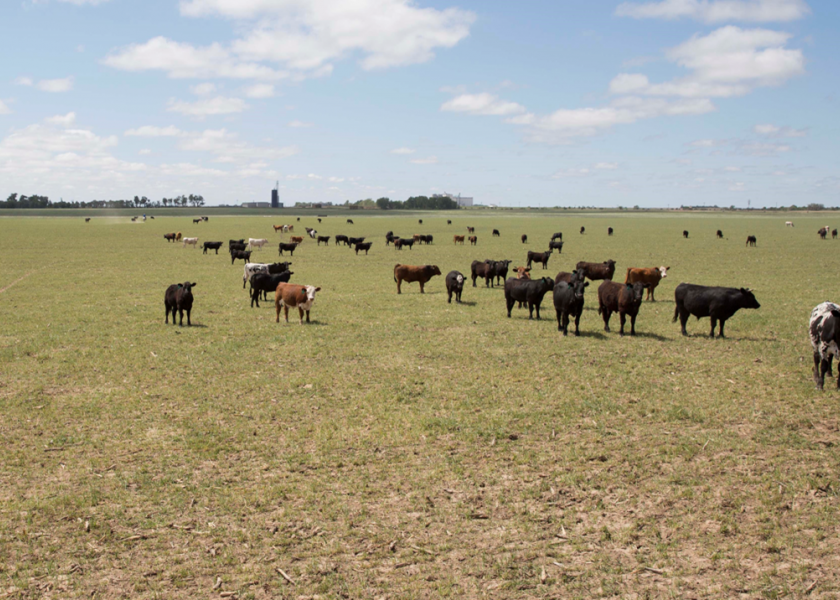Three Keys to Implant Selection During Drought Conditions

All implants aren’t created equal. That’s why a cookie-cutter-approach selection won’t deliver the best results in your stocker cattle.
Three key factors should be considered when choosing an implant—and that is especially true during drought conditions, according to Dr. Gary Sides, a beef cattle nutritionist with Zoetis strategic technical services.
Sides lists the key factors in determining which implant to use:
- The estimated number of days that animal will be on pasture
- The pasture’s forage quality and availability
- Total days of ownership
According to Sides, under normal pasture conditions, the improvement in average daily gain due to implanting ranges from 0.15 to 0.33 pounds per day.
“In a drought situation, if you have old standing forage, you need to supplement protein to improve both digestibility and feed intake,” he explained. “If you have no grass, you have to provide everything for them on pasture, or you put them in a feedlot. If the cattle are in a feedlot, then you have a whole different implant strategy.”
Sides added that if a drought occurs in the middle of the grazing season and you run short on both forage quantity and quality, you must decide whether to supplement them on pasture, or pull them from pasture and put them in a feedlot.
“Once forage quantity and quality deteriorate, cattle can actually go backwards and lose weight without supplementation,” he said.
The potency of the implant you select is dependent on both forage quantity and quality. Better pasture conditions allow for better daily gains and the opportunity to choose a more potent implant, Sides explained. Synovex® S and H (under 140 days grazing) and Synovex One Grass (SOG; up to 200-day effective payout) are excellent choices for use in normal pasture conditions.
In a drought where cattle might be gaining less than two pounds a day, Sides recommends using Synovex C, which matches the potency of the implant with the pasture conditions. He added that Synovex C is the lowest dose implant on the market approved for both steers and heifers and matches the potency of the implant with less than optimum forage conditions.
Additionally, Sides recommends not implanting cattle that are gaining less than 1.0 pounds per day because enough protein and energy are not being provided in sufficient quantities to meet the requirements of the implant. You can include a supplement with an ionophore like Bovatec® to elevate this plane of nutrition, so an implant can deliver you a return on investment.
Early Weaning Considerations
Often in drought situations, calves are weaned early—weighing as little as 200 to 400 pounds. In those instances, Sides said matching the potency of the implant with the level of nutrition of the cattle delivers the best results from the implant. Synovex C would be the best implant choice in this situation as well.
“For cattle gaining less than 1.5 pounds/day, it’s best not to use a high potency implant, since they cannot consume enough nutrients to meet the increased energy and protein requirements stimulated by the implants,” Sides said. “That’s why I like Synovex C in low forage quality conditions. For steers and heifers, it gives you great response and meets animal energy levels and growth potentials.”
Consider Days of Ownership
Sides says sometimes the best-laid plans don’t always work out. That holds true when it comes to implanting cattle during droughts.
When using Synovex One Grass (SOG) in a 200-day grazing program where marketing opportunities change or forage quality deteriorates, and cattle must be removed from pastures because of drought, then Sides said to remember the flexibility this product offers in a feedlot setting. Cattle can still benefit from the number of days left in that implant as they arrive at the feedlot.
Remember Parasite Control
In a drought, cattle tend to graze in areas containing the best forage availability. When that occurs, internal parasite infections can increase and depress forage intake and digestibility and suppress the animal’s immune system. The most effective implant strategy includes controlling internal parasites. The best treatments for parasite control include injectable products like Dectomax® or oral drenches like Valbazen®. Implanted cattle will respond more efficiently when the negative effects of parasites are eliminated.
Choose the Right Implant
Sides said an implant like SOG delivers a continuous payout throughout its 200-day label. Therefore, ensuring the nutrient needs of the cattle will be met for the entire 200-day grazing period is essential. Traditional implants such as Synovex C, S and H would be more appropriate for pastures and/or ownership of cattle for less than 120 days.







